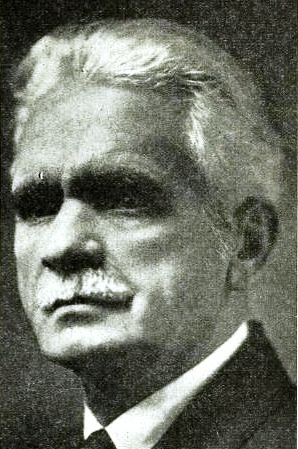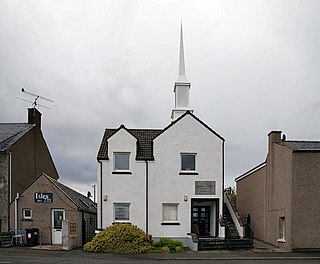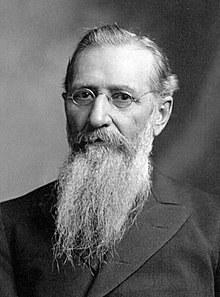The history of the Church of Jesus Christ of Latter-day Saints has three main periods, described generally as:
- the early history during the lifetime of Joseph Smith, which is in common with most Latter Day Saint movement churches;
- the "pioneer era" under the leadership of Brigham Young and his 19th-century successors;
- the modern era beginning in the early 20th century as the practice of polygamy was discontinued and many members sought reintegration into U.S. society.

Brigham Henry Roberts was a historian, politician, and leader in the Church of Jesus Christ of Latter-day Saints. He edited the seven-volume History of the Church of Jesus Christ of Latter-day Saints and independently wrote the six-volume Comprehensive History of the Church of Jesus Christ of Latter-day Saints. Roberts also wrote Studies of the Book of Mormon—published posthumously—which discussed the validity of the Book of Mormon as an ancient record. Roberts was denied a seat as a member of United States Congress because of his practice of polygamy.

Laie Hawaii Temple is a temple of the Church of Jesus Christ of Latter-day Saints located on the northeast shore of the Hawaiian island of Oʻahu. The temple sits on a small hill, half a mile from the Pacific Ocean, in the town of Lāʻie, 35 miles (56 km) from Honolulu. Along with Brigham Young University–Hawaii and the Polynesian Cultural Center, the Laie Hawaii Temple plays an important role in the town of Lā'ie, with the Visitors' Center attracting more than 100,000 people annually.

Missionary Training Centers (MTC) are centers devoted to training missionaries for the Church of Jesus Christ of Latter-day Saints. The flagship MTC is located in Provo, Utah, adjacent to the campus of Brigham Young University (BYU), a private university owned and operated by the church.
This is a timeline of major events in Mormonism in the 20th century.

The Church of Jesus Christ of Latter-day Saints was unofficially established in South Korea as early as World War II due to religious influence by LDS servicemen; however, Korean people did not begin to get baptized until the missionary efforts of LDS servicemen during the Korean War. Kim Ho Jik was the first Korean person to be baptized in the LDS Church on July 29, 1951 in New York. Two of his children were of the first four Korean people baptized in Korea on August 3, 1952. LDS Church presence and missionary work was officially established on April 20, 1956 with the arrival of two missionaries: Don G. Powell and Richard L. Detton. The Korean Mission opened on July 8, 1962 with Gail E. Carr as the first president of the mission. Successful missionary work led to the growth of the LDS Church in the 1960s and 1970s leading to the organization of the first stake in Korea in 1973 and the dedication of the first temple in Seoul on December 14, 1985.

The Campinas Brazil Temple, in Campinas, São Paulo, is the 111th operating temple of the Church of Jesus Christ of Latter-day Saints.

The basic beliefs and traditions of the Church of Jesus Christ of Latter-day Saints have a cultural impact that distinguishes church members, practices and activities. The culture is geographically concentrated in the Mormon Corridor in the United States, and is present to a lesser extent in many places of the world where Latter-day Saints live.
Sexuality has a prominent role within the theology of the Church of Jesus Christ of Latter-day Saints. In its standards for sexual behavior called the law of chastity, top LDS leaders bar all premarital sex, all homosexual sexual activity, the viewing of pornography, masturbation, overtly sexual kissing, and sexual touch outside marriage. LDS Leaders teach that gender is defined in premortal life, and that part of the purpose of mortal life is for men and women to be sealed together in heterosexual marriages, progress eternally after death as gods together, and produce spiritual children in the afterlife. The church states that sexual relations within the framework of monogamous opposite-sex marriage are healthy, necessary, and approved by God. The LDS denomination of Mormonism places great emphasis on the sexual behavior of Mormon adherents, as a commitment to follow the law of chastity is required for baptism, adherence is required to receive a temple recommend, and is part of the temple endowment ceremony covenants devout participants promise by oath to keep.

The Church of Jesus Christ of Latter-day Saints was introduced to Ghana, West Africa, in 1962. It was officially organized in 1978, following announcement of the revelation on priesthood. As of 2022, the LDS Church reported 101,924 members in 353 congregations in Ghana, making it the second largest body of LDS Church members in Africa, behind Nigeria. In 2021, Ghana ranked as having the third most LDS Church members per capita in Africa, behind Cape Verde and Sierra Leone.
David F. Boone is an American professor of Church History and Doctrine at Brigham Young University (BYU). He largely specializes in the history of the Church of Jesus Christ of Latter-day Saints in the Southern and Southwestern United States.

The Church of Jesus Christ of Latter-day Saints in Australia began with the arrival of seventeen-year-old missionary William James Barratt in 1840. The LDS Church's first baptism in Australia was in 1842 when Barratt baptised Robert Beauchamp, who would later become an Australian mission president. However, official missionary work did not begin until John Murdock, who became the first official mission president in Australia, and Charles Wandell established a mission in Sydney, Australia, on 31 October 1851. The colonies of New Zealand and Tasmania were added to the Australian Mission in 1854, creating the Australasian Mission. In 1898, however, the Australasian Mission was divided into the New Zealand Mission and the Australian Mission.

The Church of Jesus Christ of Latter-day Saints was established in Japan in 1901 when the church's first missionaries arrived on August 12. Among them was Heber J. Grant, who was then a member of the Quorum of the Twelve and later became the church's 7th president. Horace S. Ensign, Louis A. Kelsch, and Alma O. Taylor accompanied Grant. The LDS Church's first baptism in Japan was on March 8, 1902, when Grant baptized Hajime Nakazawa, a former Kannushi. The Book of Mormon was translated three times. The first translation, which took over six years, was completed by Taylor in 1909. It was then recommended that the Book of Mormon be translated into bunshō, a more elegant literary style, which was done by Chōkō Ikuta in 1909, shortly before it was published and distributed. The third translation in 1957 was done by Tatsui Sato. In 1995, the Book of Mormon was translated again into a more colloquial style.

The Church of Jesus Christ of Latter-day Saints in Germany refers to the Church of Jesus Christ of Latter-day Saints and its members in Germany.

The Church of Jesus Christ of Latter-day Saints has had a presence in the island of Ireland since at least 1840, when the Elder John Taylor first preached in Newry. He and other missionaries converted a number of Irish people, forming a branch in Hillsborough, County Down. Many of the converted Irish saints emigrated in order to escape poverty, as well as to live in majority Latter Day Saint communities. Missionary efforts continued in the 1850s, and a small branch was established in Dublin, but many members emigrated to Utah or lost interest in the church. In 1867, the Irish mission was placed in the care of the British mission. A new branch was formed in Belfast in 1884 and a Dublin branch was reestablished in 1900. All of this occurred despite anti-Mormon disturbances by local Irish people.

The Church of Jesus Christ of Latter-day Saints in Scotland is the Scottish branch of the Church of Jesus Christ of Latter-day Saints.

The Church of Jesus Christ of Latter-day Saints was first brought to the Netherlands in 1841, with the first congregation officially established in 1862 in Amsterdam. A mission to the Netherlands was organized in 1864, and the Dutch translation of the Book of Mormon was published in 1890. Membership grew in the 20th century despite challenges posed by World War I, the Great Depression, and the German invasion of the Netherlands during World War II; approximately 14,000 people were baptized into the Church during its first 100 years in the Netherlands. The Dutch government officially recognized the Church in 1955. The Netherlands Stake of the Church of Jesus Christ of Latter-day Saints was established in 1961, becoming the first stake established on the European continent. The Hague Netherlands Temple was completed in 2002.

The following outline is provided as an overview of and a topical guide to the Church of Jesus Christ of Latter-day Saints.
Elias S. Kimball was the first Mormon U.S. Army chaplain and first in any branch of the United States military. He served in the Spanish–American War with the Second Army Corps Volunteer Engineer Regiment after an appointment to the rank of captain by U.S. President William McKinley around June 19, 1898. He was also a businessperson with his older brother, J. Golden Kimball. He was a member of the Utah Territorial legislature 1888–1889 and Logan, Utah city council 1883–1884. He was a president of the Southern States Mission after his brother J. Golden Kimball, and was named a Seventy by Joseph F. Smith in 1884 and 1894.
This is a timeline of LGBT Mormon history in the 1980s, part of a series of timelines consisting of events, publications, and speeches about LGBTQ+ individuals, topics around sexual orientation and gender minorities, and the community of members of the Church of Jesus Christ of Latter-day Saints. Although the historical record is often scarce, evidence points to queer individuals having existed in the Mormon community since its beginnings. However, top LDS leaders only started regularly addressing queer topics in public in the late 1950s. Since 1970, the LDS Church has had at least one official publication or speech from a high-ranking leader referencing LGBT topics every year, and a greater number of LGBT Mormon and former Mormon individuals have received media coverage.















